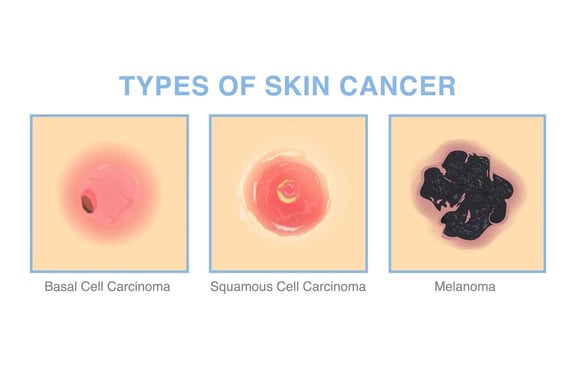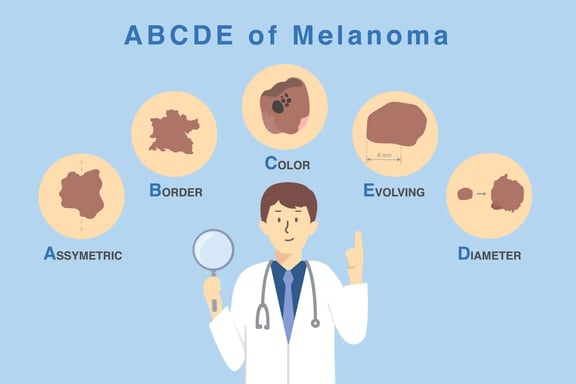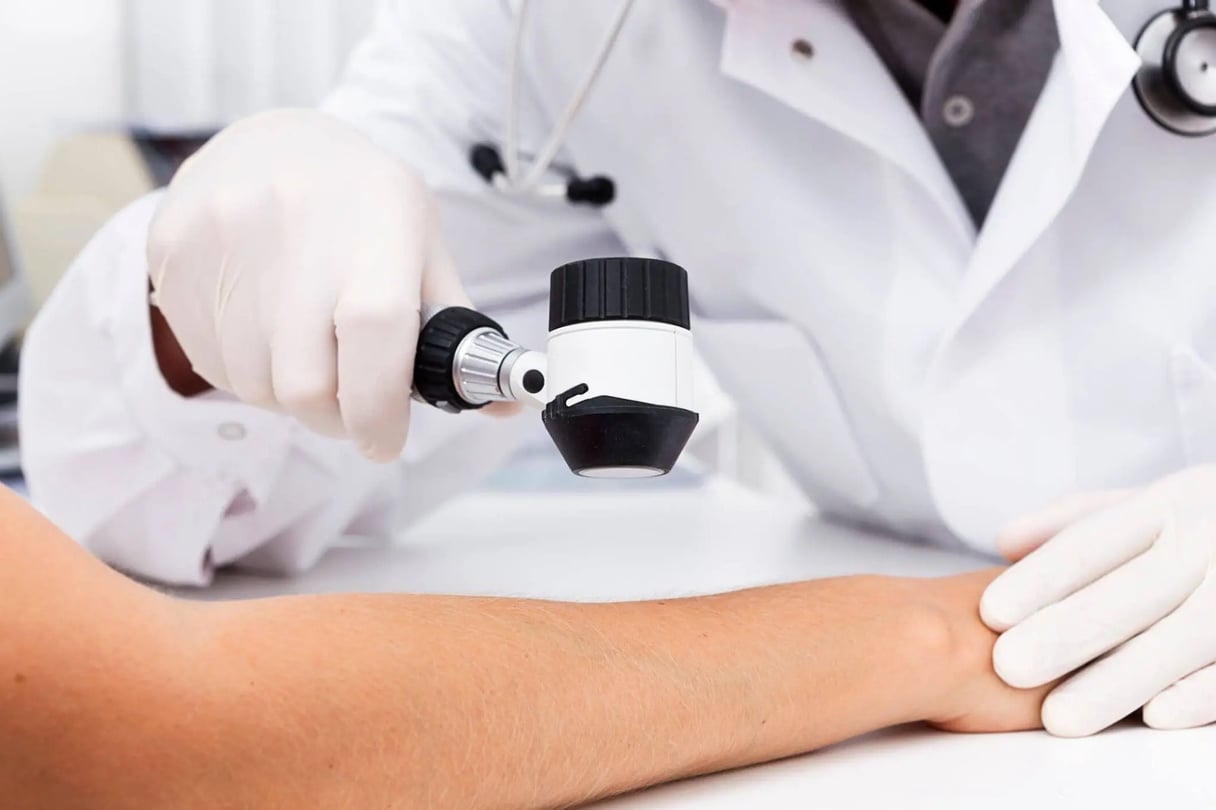Skin cancer is the most common form of cancer in the UK, with more than 100,000 diagnoses annually. It kills over 2,500 people each year and leaves thousands more needing extensive and invasive treatments.
While one review found that cannabis oil has potential anticarcinogenic properties, including the ability to inhibit tumour growth and stop its spread, medicinal cannabis is not a cure for cancer. It has shown the potential to reduce the severity of some of the symptoms that come along with skin cancer, as well as lessen the burden placed on the body by conventional cannabis treatments. It’s early days, and although there are many promising individual stories, research into its possible use as a future cancer treatment is still in its infancy.
Be wary of any company claiming that any form of medical cannabis treats or cures cancer.
With that said, let’s look into the potential application of medicinal cannabis in terms of skin cancer and see what the research is saying.
Understanding skin cancer
Despite greater awareness, education, prevention, and treatment options, skin cancer is on the rise. Increased sunbathing, travelling abroad, holidaying in places with strong sun, the proliferation of tanning studios, budget airlines, and cheap package holidays have all contributed to greater sun exposure for us Brits.
In fact, the rate of malignant skin cancer has risen 550% for males and 250% for females since the 1980s, according to a study by Brighton Medical School. Around 86% of all cancers in the UK are attributable to excess exposure to sunlight, and the steeper increase in males is down to poor sun-protective measures. And according to figures, the number of diagnoses is expected to increase further, up 9% by 2040.
Causes and risk factors
The two main causes of skin cancer are ultraviolet (UV) rays from the sun and UV from tanning beds. There are certain factors which can increase your chances of getting skin cancer.
Red or blond hair
Pale skin that burns easily
Lots of freckles or moles
Blue or green eyes
You’ve had lots of sun exposure, and especially sunburn, in the past
History of skin cancer in your family
Have used sunbeds a lot
People with black or brown skin have a lower chance of skin cancer, but it can still occur, particularly soles of the feet, palms of the hands or under a nail.

Types of skin cancer
There are two main types of skin cancer, which can be further categorised into subtypes:
Melanoma
Non-melanoma skin cancer, including Basal cell carcinoma (BCC) and Squamous cell carcinoma (SCC)
While all can have a serious impact on people’s lives, melanoma is the most serious type of skin cancer, with more than 16,000 diagnoses in the UK each year.
Melanoma
Melanoma is the most serious type of skin cancer, with more than 2,300 deaths each year and accounting for 1% of all cancer deaths in the UK. It starts in skin cells called melanocytes, which are a deep layer in the epidermis.
Melanocytes are the cells responsible for giving skin its pigment, called melanin. This pigment helps protect the skin from UV light. However, exposure to the sun can cause sunburn, which is a sign of damage to the DNA in skin cells. Over time, and with repeated exposure, this DNA damage can cause skin cells to grow out of control and lead to cancer.
Melanomas occur at any age but are more common in older people. In relation to other cancers, though, they are also quite common in younger people.
Melanoma skin cancer survival rates have doubled in the last 50 years, with nine out of ten people diagnosed predicted to survive ten years or more after diagnosis. Approximately one in 36 males and one in 47 females will be diagnosed with it during their lifetime. Melanoma is preventable in 86% of cases.
Symptoms
Moles or lesions may be asymmetric or have an irregular shape, while normal moles are symmetrical so that both halves look the same
The border on ordinary moles will be well-defined, clear, and smooth while on a melanoma they may be blurred, irregular and have jagged edges
Colour – ordinary moles tend to be all the same colour, while cancerous ones are mottled with different shades of brown and may have a black, white, pink, or blue tint to them.
Diameter – On a normal mole, it won’t generally be larger than the diameter of the blunt end of a pencil. Melanomas are usually 6 mm or wider
Changes in the appearance of a mole can signify that it is malignant
Non-melanoma skin cancer
This name is used to distinguish these types of cancer from the more serious, and there are several subtypes. Here, we explain the symptoms of the two most common types.
1. Basal cell carcinoma
BCC is one of the most common skin cancers in the UK, accounting for 75% of all non-melanoma cancers. It affects more men than women and is more common in the elderly. It begins in the basal cells, a type of skin cell responsible for making new cells as old ones die off.
Furthermore, it usually appears as a slightly translucent bump on the face or neck – areas most often exposed to the sun and is thought to be caused by long-term UV exposure.
Symptoms
BCC typically develops on the face or neck and starts as a sore or growth that won’t heal. Occasionally, growths may appear on other parts of the body that are more protected.
The lesion may have one or more of the following characteristics:
A skin-coloured, shiny bump that’s a little translucent. On pink or white skin, it can look pearly white, over brown or black skin it might look dark and shiny. Tiny blood vessels may be present, and it might bleed and scab over.
A scaly, flat patch with a raised edge which may grow larger over time.
A brown, black, or blue lesion with slightly raised, translucent edges.
A lesion that looks like a scar, which might be a little waxy and without any defined edges.
2. Squamous Cell Carcinoma (SCC)
SCC is the second most common type of skin cancer in the UK and accounts for 23% of non-melanoma skin cancers. It’s mostly caused by overexposure to UV light. However, it can also develop in areas of skin damaged by other factors such as burns, chronic ulcers, forms of radiation and old scars.
It develops in the middle and outer layers of the skin, in cells called keratinocytes, and although not life-threatening, it can be aggressive, growing large in some parts and leading to serious complications.

Symptoms
Patients most commonly find lesions on parts of the body regularly exposed to the sun such as the scalp, face, hands, lips, and neck. However, they can occur anywhere on the body, including inside the mouth and on the genitals.
Symptoms of SCC can include:
A flat sore with a scaly crust
A nodule that is firm and red
A rough or sore patch inside the mouth
A scar with a new sore or a raised area
A rough, scaly patch on the lip, which may become an open sore
A raised, wart-like sore found on the anus or genitals
Other rarer types of non-melanoma skin cancers are:
Merkel cell carcinoma
Kaposi’s sarcoma
T cell lymphoma of the skin
Sebaceous gland cancer
Treatment
Surgery, chemotherapy, radiotherapy, chemical peels, and immunotherapy are some of the most common treatments. However, they all carry their own risks and have some unpleasant side effects.
In the case of skin cancer, treatment will be predicated on the type of cancer and if/how far it has spread. With BCC, it rarely spreads, so excising the mole or lesion and performing a biopsy might be sufficient. If it’s a large SCC or suspected melanoma, further tests will be carried out to determine its spread, which might include medical imaging and examination of neighbouring lymph nodes and biopsy. Cancer is then graded with Roman numerals I to IV – I mean it is small and localised, while IV indicates it is advanced and has spread to other parts of the body.
CBD oil: What is it?

Cannabidiol oil, or CBD oil, is a popular natural remedy that has really come to prominence in the past decade or so. Although it is derived from the Cannabis sativa L. plant, it won’t give you a high because it doesn’t contain any of the psychoactive compound tetrahydrocannabinol (THC).
It does, however, contain cannabidiol (CBD) – the second most active of a group of compounds called cannabinoids, offering many potential positive health outcomes. CBD predominantly comes from the flowers of the plant. Many extraction methods are used to create CBD oil, one of which is to soak the plant in solvents to strip out the cannabinoids. The liquid is then evaporated, which leaves the cannabinoids in a concentrated oil form. This crude oil is then refined and purified to create a pure CBD isolate or a broad-spectrum oil.
CBD oil can be found in various health supplements, taken orally under the tongue, used topically on the skin, or ingested with food. Certain CBD oil products allow the use of vaporisers for inhalation. Oils available on the market come in various concentrations and are legal in the UK. They must contain less than 0.2% THC or be rendered illegal.
There are also a bunch of cannabis strains, both sativa and indica leaning, with elevated levels of CBD but minimal THC.
The potential beneficial properties of cannabis oil for skin cancer
Several studies have pointed to the potential various therapeutic benefits of cannabis oil for skin cancer patients. They have shown cannabis may have the potential to cause cancer cell death, block cancer cell growth, stop the development of blood vessels which tumours need to grow, reduce inflammation, and reduce the ability of cancers to spread.
These are all preliminary findings, and as we stated at the beginning of this article, there is (at the time of writing) zero evidence to show that medical cannabis alone can cure cancer or stop the spread of tumours. Below, we are simply showing what the current research has concluded, but we are not making any anti-cancer claims regarding medicinal cannabis therapy.
Medicinal cannabis should be viewed as one small part of a holistic treatment plan.
Cancer Cell Death
Apoptosis is the programmed death of a cell and is a necessary part of its normal life cycle. Cancer cells reproduce rapidly without dying like normal cells, which damages surrounding tissues and causes tumour growth. A 2009 study found cannabis had the potential for immunosuppressant and apoptosis abilities, allowing malignant cells to ‘die’ naturally.
Block Cancer Cell Growth
Experimental studies have shown cannabis may have an antitumorigenic effect, potentially stopping tumour growth and killing cells. In one 2009 review, researchers noted cannabis might induce this effect in lab tests on immune-related cancers such as leukaemia, though it didn’t specifically mention non-immune-related skin cancers. Another study noted that cannabinoids were potentially able to bind to receptors on melanoma cells to reduce growth and increase cell death.
Prevent the Growth of Blood Vessels
Cannabis has been shown to have potential angiogenic properties, which means it inhibits blood vessel growth, something cancer cells need to survive. This potential was shown both in lab tests and in animal testing, and according to one study, medical cannabis may have the prospective capacity as a future effective agent for cancer treatment. Another 2022 study, which looked at cannabis in the context of Covid-19, also found it may decrease blood vessel growth.
Anti-inflammatory
Numerous studies have found CBD to exhibit potential anti-inflammatory properties. One review paper found that it could possibly provide a skin tumour-preventative effect because inflammatory processes are associated with tumour growth, but CBD’s anti-inflammatory properties may counteract it. It also showed cannabinoids could increase antioxidant activity, which could in turn, protect against skin cancer.

All of these findings are preliminary and should not be viewed as anything resembling definitive claims that medicinal cannabis can cure or treat skin cancer.
The potential treatment of skin cancer
While the science is promising, there has been limited clinical study on cannabis oil to confirm its efficacy in treating skin cancer. However, it is already being used to aid cancer sufferers undergoing chemotherapy – Nabilone is a drug developed from cannabis and used to treat severe nausea and vomiting in patients for whom other anti-sickness medication has failed. With further research, there is a possibility that more cannabis-based medications will become available to treat the side effects of cancer.
Conclusion
The narrative surrounding medicinal cannabis, particularly in the realm of skin cancer treatment, is undeniably a captivating one. The preliminary research findings hint at the potential of cannabis oil to disrupt the conventional paradigms of cancer treatment. The glimpses into its ability to induce cancer cell death, halt tumour growth, and inhibit blood vessel proliferation open up a conversation ripe for further exploration.
However, it’s imperative to tread this path with a grounded perspective. The studies cited are initial steps in a potentially long and rigorous journey towards establishing concrete evidence. The promise shown by cannabis oil is enticing, but it’s essential that we anchor our expectations in the realm of scientific rigour and clinical validation.
While medical cannabis oil showcases a glimmer of hope, the medical community has yet to arrive at a consensus. The current landscape calls for more extensive clinical trials, larger sample sizes, and robust methodologies to ascertain the true efficacy and safety of cannabis oil in skin cancer treatment. As of now, the narrative of cannabis oil as a part of a comprehensive treatment plan for skin cancer remains within the bounds of potential rather than established facts.
The dialogue between cannabis and cancer treatment is evolving, and as it does, the hope is that the veil of uncertainty will gradually lift, paving the way for well-informed decisions and, perhaps, novel treatment avenues. Until then, the journey of discovery continues, with each study propelling us a step closer to a more profound understanding of the cannabis skin cancer nexus.












.jpg)